#Vegetarian Burger
Explore tagged Tumblr posts
Text





[That's a better vegetarian burger than a lot of meat burgers I've had. They convey neither conviction nor authority and the beans and the flaxseed, and I love the color that you pick up from the chilies.]
#s32e07 crazy chicken twisted burgers#guy fieri#guyfieri#diners drive-ins and dives#vegetarian burger#meat burgers#lot#conviction#authority#beans#flaxseed#color#chilies
2 notes
·
View notes
Text

Savor Every Bite with Our Irresistible Veg Burger Recipe!
Craving a hearty and flavorful meal? Try our mouth-watering veg burger recipe! Packed with wholesome ingredients and bursting with flavor, this burger is perfect for gatherings or a cozy night in. Easy to prepare and absolutely delicious, it’s a must-try for burger lovers. Get the complete recipe at Veg Burger Recipe on B Burger!
0 notes
Text

Vegetarian Burger-
Potet Burger with cheese, salad, and house dressing, served with sweet salsa. - Source menu
Allergens
Contains gluten.
Contains eggs or products thereof.
Contains milk or dairy products (including lactose).
Contains mustard or products thereof.
#food photography#Vegetarian Burger#potato burger#veg cheese burger#cheese veg burger#chaskka restaurant#veg burger in chaskka#chaskka oslo#oslo indian food#burger in oslo
1 note
·
View note
Text

0 notes
Text

A vegetarian burger with onion rings as a side dish I had at a restaurant called Louisiana.
0 notes
Text
The power of hotdogs
Danny is running to Gotham to escape the GIW. As he’s running into an alleyway, he crashes into non other than condiment king who proceeds to attack and hits the GIW goons behind him. This absolutely terrifies them due to the fact that their prestigious white clothes will be stained. The fact that he has people running in terror gives Condiment king a giddy feeling so he proceeds to chase them around Gotham.
Thus starts Danny’s constant exploits of running to condiment king when he’s being chased and the rogue scarring the living daylights out of the GIW. They develop nightmares and Condiment king starts developing new concoctions that will specifically stain clothes and never come out. Mwa ha ha!
Eventually, Danny gets adopted by the rogue and becomes his sidekick. Now, when people learned that condiment king got a new sidekick, they laughed. Who in their right mind would want to mentor under him. They believed that this was some poor sob who was down on their luck and truly desperate. That or some weirdo like the ‘king’ himself.
But they didn’t understand.
They didn’t understand that they should never have let Danny Fenton (known as Phantom) become Condiment King’s sidekick.
Danny knows how to animate hotdogs and other foods to create an army. Danny knows intimately about the secret nasty burger sauce that is capable of powerful explosions of you heat it up. Danny has knowledge in the usage and how to build various weaponry designed to shoot or even be powered by green sludge (which can easily be replaced by ketchup, mustard, or relish).
And he hasn’t even shown Gotham his power-set yet. No one knows why he calls himself phantom. For all they know, he’s just a normal (terrifying) human.
Everyone blames the GIW for this mess.
#Dpxdc#dcxdp#Kizzer55555 ideas#all hail condiment king#Danny becomes condiment king’s sidekick.#Danny gets adopted by condiment king#He makes it everyone’s problem#Army of hotdogs#Hotdog henchmen.#The nasty burger sauce is weoponised#Don’t worry though#Danny doesn’t kill anyone#Everyone learns to FEAR condiment king’s sidekick.#Sure he’s the only rogue that doesn’t kill but he is so much worse.#The bats regret their life choices.#The bats regret they didn’t stop this.#The entirely of Gotham hates the GIW.#Even the rogues#This is all their fault.#Condiment king and Danny raid a food market and start a hotdog uprising#He drives many people to vegetarianism.#Damian is the only one happy about Danny being Condiment king’s sidekick.#Danny cannot drive.#He build a weoponised food truck.#These two things are related.
3K notes
·
View notes
Text
Potential DPxDC Prompt x3
In between their graduation from high school and the start of their college careers, Tucker and Danny collaborate on a small podcast where they mostly chitchatted about various topics from "Is a hotdog a sandwich?" to "Why the Justice League sucks." That last one upped their viewership, but most of that died off when the next three episodes were titled "The Best Eats in Nowhere, Illinois," where they trolled through Elmerton and Amity Park for the various chain and local restaurants, eating at and rating them with a very qualitative, subjective, and nonsensical scale, until they get to the Nasty Burger. The Nasty Burger gets an episode all to itself, describing the lore of how the "T" in the original "Tasty" fell off, the sign got tagged with an "N," and how, after it took years for the owners to fix the sign, they officially renamed the place "The Nasty Burger" because that's what everyone called it, even changing the menu and marketing that had stubbornly stuck to Tasty Burger all those years. (Tucker shows off his vintage Tasty Burger shirt as a flex of his loyalty). They order and eat every food item in one sitting (even the vegan ones), and rate Nasty Burger 20/10, the best local burger place you can find. After the drop off that came from reviewing places like "The Lucky Sombrero Irish Pub and Taquería," they didn't expect the clapback they got from the most unexpected place: Gotham, New Jersey. A small but very robust group of Gothamites were calling bullshit on the review, daring them to come to Gotham for their own local burger chain, The Batburger. Tucker and Danny sense a great challenge and a new episode idea, and Sam agrees to fund the trip when they declare the vegan options at the Batburger were far superior ("I funeded the separate grill myself at Nasty! Bet they cook their bean burgers in beef grease.") Of course, she's also coming along. So Tucker, Sam, and Danny hit the road with a teaser that they're taking up the challenge and coming to Gotham, and they'd be proving these uppity commentators WRONG. Meanwhile, The Batclan are a bit shocked to realize that their comments actually motivated the hosts of one of their favorite dumb podcasts, which appeared on their radar after the "JL sucks" episode, to visit Gotham. Wouldn't it be hilarious if they tracked them down and got to see their reactions in person?
#dpxdc#dp x dc#They're planning to visit every Batburger too. Which is only like four or five throughout Gotham with one in Metropolis.#Sam vows to verify if the vegan and vegetarian options are ACTUALLY following protocol or#if they're just frying them up on the same grill as flesh#Tucker vows to try every item on the menu and compare it to the Nasty Burger equivalent. He's developed a very comprehensive scoring sheet#for the occasion#Danny heard they had special toys. He's getting every single one and using them for his stop motion animations channel#(it's a much easier task when you bribe the Master of Time with fudge to “fudge” the passage of time somewhat)
296 notes
·
View notes
Text

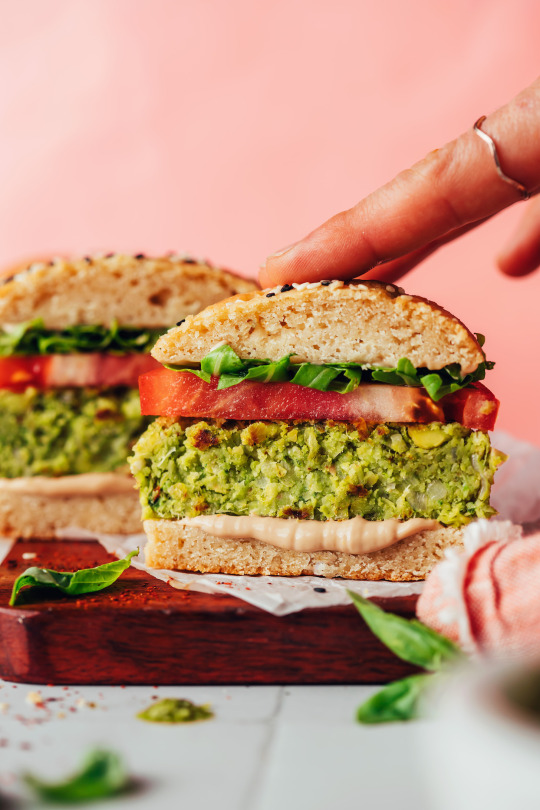
Pesto Veggie Burgers with Balsamic Aioli
389 notes
·
View notes
Text
If you enjoy the star trek voyage home movie, I highly recommend reading the novelization! There's a lot more detail in the book versions of the movies that they can't squeeze into the film format
To argue my case, I present the scene where Gillian drives them back to the park
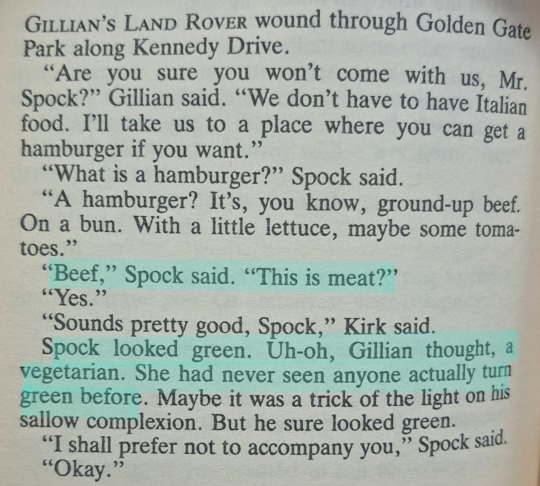
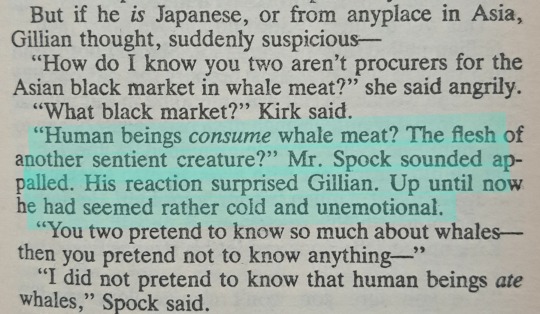
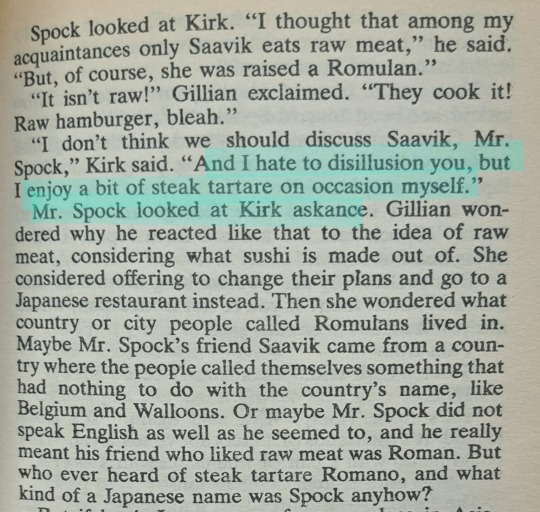

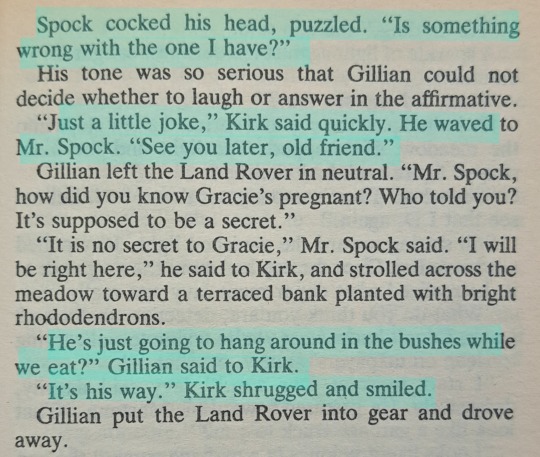
A wonderful bonus, once kirk returns from his dinner with gillian

#star trek#tos#the original series#spock#kirk#spirk#space husbands#the voyage home#star trek iv#the one with the whales#spock in his relearning stage still and assuming everyone is also vegetarian is adorable#either that or the replicators are 'vegan/vegetarian based proteins' thing but im not sure if that was a tng oneard thing#so spock knowing kirk eats meat whatever before he dies#spock back to life having memories of eating with kirk in the dining space on the entwrprise#dude had a chicken sandwhich#but post mortem spock just assumes this is a 'chicken' burger from the replicator and everyones vegetarian in the enterprise#and being HORRIFIED#when he learns kirk sometimes eats meat#and near-raw meat#is so funny
630 notes
·
View notes
Text

Crispy Bang Bang Chicken Fried Shroom Sandwiches With Broccoli Slaw
#eatfigsnotpigs#kfc#super bowl#burger#burgers#chicken#mushroom#mushrooms#bang bang#fried mushrooms#broccoli#slaw#lunch#dinner#savoury#whatveganseat#what vegans eat#vegan#veganism#vegetarian#m3ansp0#low cal restriction#b0dy ch3ck#th1gh g@p#light as a 🪶#sk11ny
98 notes
·
View notes
Text
Pigs Eyes & Crying Elephants: Sentient Beings Manifesto

A commercial with a crying elephant & the eyes of a pig.

I saw the elephant commercial for an animal welfare group last Tuesday during NXT.
That is what started all of this.
I was vegetarian for two years from 2013 to 2015 meaning I didn't eat any meat or seafood but I did eat eggs & consume dairy.
Then I started eating meat again in 2015.
Then about a year ago, I decided I would eat vegetarian during the week (Monday through Friday) and then eat meat & dairy on the weekends -- so my diet was 75% vegetarian for the past year.
But I was still eating all the chocolate, cheese & all of the dairy tingz.
Then I saw a commercial last week during NXT with a crying elephant. It really got to me.
I started during research on elephants & emotion. Turns out elephants pass the "mirror test" and are self-aware.
So are dolphins.
That led me down a rabbit hole where I started researching the emotional self-awareness of other animals and was surprised to find similar findings for pigs, chickens and cows.
And monkeys -- rhesus macaques are endlessly tortured for human medication. They are extremely self-aware and emotional.

I questioned myself on why my 75% vegetarianism diet shouldn't be 75% plant-based (vegan).
And I realized that I didn't want to give up exactly two things: cheese & chocolate.
And hell no, I didn't want the vegan alternatives.
But I started researching the dairy industry which then led me to researching CAFOs (commercial agricultural feeding operations) aka factory farms aka hell on earth aka infinity mirrors of animals being tortured endlessly.
10 billion land animals are slaughtered every year in the United States. Millions a day.
Is that really necessary?
Then I realized that the dairy industry was the plot to a dystopian sci-fi novel:
Women are forcibly impregnated, their babies taken from them immediately after being born — the baby boys are killed within 1 to 4 days, the girls are imprisoned to be forcibly impregnated just like their mothers.
The impregnation cycle is relentless and there are absolutely no breaks between artificial insemination - impregnation - birth repeat.
The woman are also given artificial growth hormones to force them to grow bigger & more quickly — the easier & quicker to impregnate them.
The women are kept in stalls that are so small & overcrowded they cant even move or turn around.
The women never see natural sunlight.
They are only allowed out of their stalls to give birth.
They are forced to endlessly lactate and pumped by machines so mercilessly that they bleed.
I still didn't feel that I could give up cheese 75% of the time.
Then I questioned myself on why not.
I have done very restrictive very low calorie diets in the past. I used to work out 2 hours a day, 6 days a week. I used to have a six pack.
I broke my 13 year addiction to the NFL & won't even be watching the Super Bowl once a year as of this year.
Why then is not eating cheese 75% of the time a seeming impossibility?
That was honestly how I felt.
So, I googled and found this:
Cheese contains casein. This is what causes such intense cravings. It also contains casein fragments called casomorphins, a casein-derived morphine-like compound. Dairy protein has opiate molecules built in. When consumed, these fragments attach to the same brain receptors that heroin and other narcotics attach to. Casomorphins cross the blood brain barrier and attach to dopamine receptors.
Cheese is literally 10% as addicting as morphine.
Yet they (do ask yourself who they is) have the motherfucking audacity to say it is "no more addictive than anything else that could be addictive, like Pringles or fast food."
First of all -- they are simply proving the point as those foods -- OPFs or overly processed foods & fast food -- also are highly addicting by deisgn, they are literally made to be. Study after study has confirmed that the most addictive foods are foods that are highly processed, high in fat, high in sodium and/or sugar.
Checks out, right?
What foods do you consider the most addicting?
Probably Oreos, potato chips, pizza, french fries, mozzarella sticks, fast food, donuts, cookies, brownies, pretzels, burgers like anyone else.
Right?
They are designed that way on purpose.
They create addicts on purpose for profit.
Cancer, diabetes, hypertension, high blood pressure, artherosclerosis, blood clots, immune system disorders, heart disease, stroke, heart attacks are all caused by diet & lifestyle.
It is a very lucrative business for them.
A million people are already on Wegovy babes?
It's a set up.
They make the food that makes people sick and they make the medicine that people buy after they buy the food that makes them sick. The above diseases did not exist at the current rate even 100 years ago. It's due to OPFs (overly processed food), PFAs (forever chemicals), toxins, sugar substitutes, partially hydrogenated vegetable oil (transfat), high fructose corn syrup, modified food starch, monosodium glutamate, dextrose, sucralose, lecithin, emulsifiers, aspartame, genetically modified organisms (GMOs), bioengineered ingredients, pesticides, artificial flavors & colors, preservatives, synthetic lab-made chemicals.
Capitalism is nothing but a death cult.
Wake up.
They are literally made that way on purpose & designed to be addictive.
But the way that casein is addictive is truly unique because it is binding itself to receptors in our brains the way that morphine & heroine does.
So, I decided I want to do something that is sustainable in the long-term 15 & 20+ years from now. I am 43.
I don't play an all or nothing zero sum game of zealotry where it's something that is impractical.
I look forward to the weekly meals with my husband.
We have been together for 17 years and have been married for over a decade.
I've looked at thousands of recipes over the years and have curated a Top 100 list of our absolute favorite receipes plus ones that I want us to try.
We always make a meal on the weekend & post the pictures on his Facebook.
While we eat our weekly meal, we talk, hang out, watch stuff on Youtube, baseball, basketball & wrestling.
It's one of the things we look forward to doing together as a couple the most.
He is the quintessential "meat & potatoes guy" but when I started eating vegetarian 75% of the time last year, he agreed to eat vegetarian 3 to 5 days a week.
He does eat meat & dairy the other days of the week.
I have decided that maintaining our weekly meals ritual as a couple is important to me.
So, for this to be sustainable it has to allow for our weekly meals to have meat and/or dairy -- and also, during the holidays, I want to be able to eat meat and/or dairy.
Other than that, Monday through Friday, my plan for the rest of my life is to eat a vegan (plant-based) diet 75% of the time -- no meat, seafood, dairy or animal-based or derived ingredients or by-products.
I immediately went through my apartment this morning once I had decided on this & was disappointed at how many of my snacks weren't vegan -- Annie's Organic granola bars, Nature's Bakery Bars & literally all of my remaining Halloween candy (Take 5, Reese's Cups, Crunch, & candy corn).
I gave it all to my husband in a bag this morning for him to take to work.
Since they are snacks that I ate on a daily basis, it is better to remove them from the apartment as my goal is to now eat vegan (plant-based) diet 75% of the time, Monday through Friday.
Staring at a bag of my absolute favorite non-vegan candy corn isn't exactly going to help me achieve that.
Vox When asked in an interview on the Climavores podcast why farms aren’t regulated to reduce pollution, USDA Secretary Tom Vilsack said there are simply too many farms to regulate, and that conservation efforts should be voluntary
According to Civil Eats, a nonprofit publication covering the US food system, nearly all animal agriculture operations are exempt from federal protections under the Occupational Safety and Health Administration, and the agency doesn’t respond to 85 percent of worker fatalities on animal farms.
Most states exempt livestock from anti-cruelty laws, and many states have passed “ag-gag laws,” which criminalize activists and journalists for simply recording what goes on at farms.
All 50 states have so-called “right to farm” laws, which prevent citizens from suing farms for nuisances like pollution and odor that degrade their quality of life.
A recent analysis from Stanford University researchers found that from 2014 to 2020, the US livestock sector received about 800 times more public funding than the meat, egg, and dairy alternatives sector.
Farmers are heavily overrepresented in government, with 25 current members of the US House of Representatives, or their family members, having collected millions of dollars in agricultural subsidies. That’s almost 6 percent of the chamber, even though just about 1 percent of Americans live on farms. The dynamic is the same at the state level.
Corn and soybean production, most of which is dedicated to ethanol and livestock feed, accounts for half of all crop cash receipts.
Don't you think some of the children literally starving to death right now in North Gaza in Palestine could have used some of that corn & soybean? No? The livestock that we don't need to eat because we don't need meat to survive needed it more than the children literally dying from starvation right now in North Gaza?
Vox Raising livestock requires far more land and water than growing plant-based foods — and produces far more pollution.
Over the past decade, the animal-agriculture industry has been behind the introduction of "ag-gag" bills in more than half of all state legislatures across the country. These dangerous bills are designed to silence whistleblowers revealing animal abuses on industrial farms. Ag-gag laws currently exist in six states, penalizing whistleblowers who investigate the day-to-day activities of industrial farms, including the recording, possession or distribution of photos, video and/or audio at a farm.
The USDA never conducts surprise audits, or any audits at all, to verify the company is telling the truth. It is, in essence, an honor system. The USDA also has an incredibly low, and often nonsensical, bar for what passes as humane treatment.
Over the course of more than a dozen shifts at multiple Foster Farms facilities, the investigator — who requested anonymity due to the covert nature of undercover investigations — documented workers slamming birds into crates, kicking and hitting chickens, and numerous instances of forklift drivers running over birds.
The investigator recalled making eye contact with a bird shortly after they were run over by a forklift. ���They were being crushed and everything was being pushed forward, and they had their beak open, and they had this look on their face like they knew that they were dying,” the investigator told me. “And then I watched them flap and struggle for a moment before passing.”
The investigator chalked up most of the cruelty to the chaotic, fast-paced work environment imposed by supervisors during long, grueling shifts.
But you wouldn’t know that from its marketing or its “American Humane” certification.
Chickens raised for meat in America -- 98% of land animals that get slaughtered each year in factory farms -- are five times bigger today than they were in the 1950s! In 1957, chickens on farms raised for meat were 907 grams. In 1978, chickens on farms raised for meat were 1,808 grams. In 2005, they are 4,202 grams! WHERE IS OUR HUMANITY???????????
Vox American Humane allows for the standard chicken slaughter process: shackling chickens upside down, dunking them in a bath of electrified water to stun them unconscious, slitting their throats, and then placing them in a scalding vat to loosen their feathers.
Despite all that, the resulting meat can still be advertised as humane, sustainable, and produced from healthy birds.

Currently, chickens and other poultry birds have zero federal legal protections while on the farm or in the slaughterhouse.
During their short stint on behalf of the Washington, DC-based animal rights group Animal Outlook, the investigator documented hours upon hours of the typical horrors found on chicken factory farms: tens of thousands of birds stuffed into dark warehouse-sized barns, many of them severely injured with gruesome lesions, injuries, and deformities. At more than one point, birds are deprived of feed or water, and there was also a rat infestation and footage of bugs crawling in the chickens’ feed.
The conditions are visibly at odds with Tyson’s advertising claims that it treats animals humanely and raises “happy” and “healthy” chickens.
“It’s just a living nightmare,” the investigator, who requested anonymity due to the covert nature of undercover investigations, told Vox. “A video just does not do it any justice.”
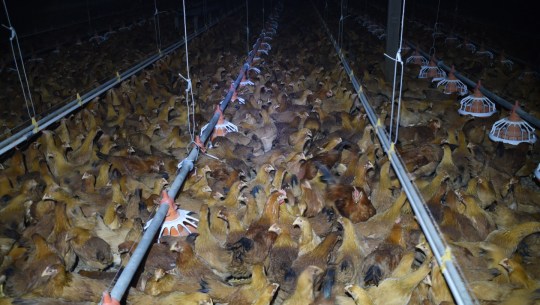
Despite the horrific findings, they’re not all that different from the conditions documented at other farms that raise chickens for Tyson and Tyson’s competitors. The US Department of Agriculture (USDA) says chicken producers using the label “free-range” must provide birds “continuous, free access to the outside” for over 51 percent of their 6.5-week lives.
Is 6.5 weeks a life?????????????????????
In another portion of Animal Outlook’s footage, when the investigator asked the farm manager why so many chickens couldn’t move, he was blunt:
“They’re just fucked up.”
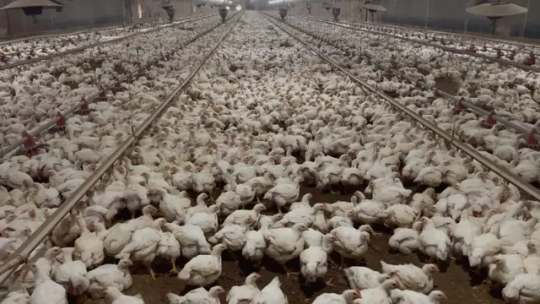
According to a 2021 ProPublica investigation, humane-labeled chicken is often processed in the same slaughterhouses, owned by companies like Tyson, as conventional meat.
“You almost couldn’t design a more torturous setting,” she said, adding that the video shows dying and dead chickens in “advanced states of decomposition” with the potential to “spread infectious disease to the other birds, human workers, and unsuspecting Tyson customers.”
WHERE IS OUR HUMANITY???????????????
Animal Outlook’s investigator also documented bugs crawling in the chickens’ feed, and rat infestations — problems echoed by the Tyson technician in the undercover video.
“The little baby chicks are gonna peck at those bugs, eat them, and then they’re gonna die,” Tyson’s technician told the farm manager in a conversation recorded by the investigator.
“You got rats in there, you got fresh rat activity in all your houses.” Despite these known issues, Animal Outlook alleges Tyson delivered fresh chicks to the farm.
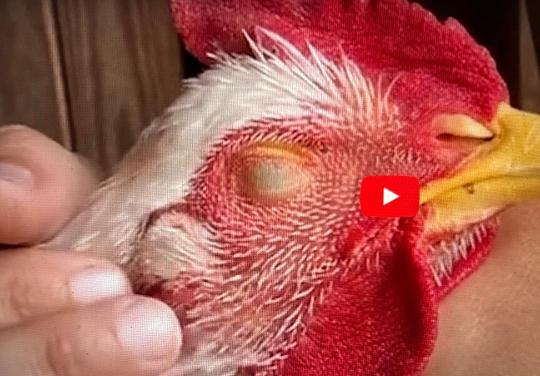
As journalist Eyal Press, author of Dirty Work, a book on jobs in morally troubling industries like poultry, put it in a Vox podcast interview: “On the rare occasions when the curtain is pulled back and we see this dirty work going on, the blame goes to the lowest-ranking people at the bottom, and that’s very convenient for society.”
Ofcourse it is -- society still wants their Wendys Spicy Nuggs.
Vox However, holding meat companies legally accountable for how they treat animals is exceedingly difficult because there are no federal laws that protect animals while on the farm, and birds are exempt from federal slaughter and transport law.
Chickens raised for slaughter are bred in "high stocking densities", meaning they are unable to "move freely to flap their wings" or show "natural behaviors".

"They [Frankenchickens] have been bred to eat at an extraordinary rate so they put on this completely inappropriate weight gain just to get to market as quickly as possible."
If you are a starseed, understand our mission is to break up & dismantle Big Meat & Big Ag (& ofcourse Big Oil, Big Pharma, etc...): LPE Project
Today four massive companies – JBS, Tyson Foods, National Beef, and Cargill – control over 80 percent of America’s beef. Three companies – JBS, Tyson, and Smithfield Foods – control 63 percent of America’s pork. Two of those – JBS and Tyson – also control 38 percent of poultry. The grain, seed, farm equipment, agrochemical, livestock genetics, and animal pharmaceutical industries have likewise become highly consolidated.
These companies possess dominant market power as both sellers of meat and buyers of livestock, which they used to raise prices for consumers and lower prices paid to farmers.
In 1971, President Richard Nixon appointed Earl Butz – who at the time served on multiple agribusiness boards – to lead the USDA, opening a revolving door between the industry and the agency that has swung non-stop ever since.
Under Butz, subsidies for fossil-fuel-intensive monocultures led to a glut of cheap grain, which in turn led to factory farmed animals. “Since factory farms could buy grain for less than it cost farmers to grow it, they could now fatten animals more cheaply than farmers could,” wrote Michael Pollan.
In the last year, top companies in every major American meat sector – beef, pork, chicken, and turkey – have been subject to civil suits and/or federal investigations for conspiring to keep prices high. One lawsuit estimates that chicken industry price-fixing alone costs the average American family of four $330 per year.
The primary reason multinational meat conglomerates have flourished, and meat prices have remained artificially low, is that our government massively subsidizes them at everyone else’s expense.
Our government subsidizes Big Meat directly by allocating the bulk of federal crop subsidies to large farms growing animal feeds, by financing animal factory infrastructure, by buying billions of dollars of their products, and much more. In exchange for this support, taxpayers get hijacked federal agencies, policies shaped by pro-industry academic research, a less responsive democracy, and forceful industry lobbying to keep it that way.
It does this by failing to regulate the environmental impacts of factory farming, including the industry’s role in contaminating air, poisoning drinking water, and driving the climate crisis; by failing to require safe conditions for slaughterhouse workers; by denying most farmworkers the rights to form unions and earn minimum wage and overtime pay; by exempting “common farming practices,” no matter how cruel, from most state animal anti-cruelty statutes; and by failing to restrict the industry’s use of antibiotics (used to speed growth and keep overcrowded animals alive) despite the resulting increase in drug-resistant infections.
Farmer suicide rates are now 3.5 times that of the general population.
It is now commonplace for pigs (and their diseases) to be trucked hundreds of miles across the country without food, water, bedding, protection from extreme temperatures, or adequate space.
BedlamFarm.com One of these happenings was the discovery by scientists in New York in the 1950’sthat by adding tiny traces of antibiotics to animal feed they could increase the growth rates of animals.
With these new tools, farmers could concentrate animals in confined areas on a scale never before possible.
This was soon to be called “factory farming” by the few voices raised in alarm. The term has never been complimentary..
At the same time as the geneticists made their discoveries, Earl Butz, Dwight Eisenhower’s Agriculture Secretary, defined the new future.
It isn’t clear if Butz, a crude by visionary agriculture economist, saw the coming future or created it.
Farms, he said, and farmers had to consolidate, corporatized, embrace economies of scale, just what most family farmers would never do. The economists picked up this cry, and the family farmers never had a chance.
Butz was serious, perhaps prescient. He meant that in order to survive, farmers must pursue a new corporate model for farms – maximize profits, minimize loss.
Corporations jumped into farming big-time, buying giant tractors, hiring biologists and geneticists to redesign animals and turn them into unhealthy freaks with short live spans and no resistance to illness, parasites, or viruses, setting up distributions systems that could even sell milk and meat overseas.
On the corporate farms, when a cow gets sick, it is instantly put to death, veterinary care cut into profits, the cow just goes to slaughter.
The average live span of a milk cow, says the Agriculture Department, plunged from 12-15 years to two years by the 1990s. Cows on corporate farms never set foot outside, some never left their stalls, get no exercise, and are bored almost senseless.
Where is our humanity?????????????????
There is no stimulation in their lives, no change of scenery no hed for these herd animals, no walk, grazing, or hanging out with other cows, a cow’s favorite activity.
They live as long as they can produce more and more milk, and when they can’t, they die.
For animals, life became an Orwellian horror show, their very bodies, and spirits taken from them as they were genetically engineered to be profit centers, not animals with human caretakers and individual personalities and traits.
So have the chickens and pigs, many of whom live their lives without ever standing up in factory farms, mostly in the mid-central United States.
Most Americans will never see what is happening to these animals or even hear about them.
The people who increasingly have taken over the care of the animals we eat are sometimes the cruelest and most immoral people who have ever come within a hundred miles of a farm.
Comment to the above article: A quick google search reveals legislation proposed to add oversight to use of antibiotics in animals in 2018, 2017, 2013, 2002- all fought by Big Pharma. Often with the same ferocity and tactics used by Big Oil to fight against regulations to slow climate change.
ForksOverKnives: The USDA is tasked with setting the nation's nutrition guidelines. Yet this is in direct conflict with its primary interest: ensuring the profitability of producers of foods such as dairy and meat. These foods are known to increase the risk of obesity, diabetes, cancer, and cardiovascular disease. Is it any wonder that programs administered by the USDA and funded by the Farm Bill preferentially feed school children and the poor unhealthy foods that cause chronic disease?
The farming practices that underpin our healthcare crisis also degrade our environment. To grow vast swaths of these monoculture crops, enormous amounts of chemical fertilizers, pesticides, herbicides, and fungicides are required. Many of these agricultural chemicals are suspected endocrine disruptors and carcinogens that are thought to alter human DNA down through the generations.
During my lifetime alone, annual worldwide pesticide production has increased from 200,000 tons to more than 5 million tons, according to estimates from The Food and Agriculture Organization of the United Nations. It has gotten to the point that many of these chemicals now rain down upon us. These pesticides wipe out beneficial and native wildlife such as honey bees, monarch butterflies, and songbirds.
A Happy Meal? If, by eliminating Farm Bill subsidies, the cost of a Quarter Pounder with Cheese were to rise from, say $4 to $15, eating habits would likely shift toward eating healthier foods, especially if at the same time, a program were put in effect to incentivize the consumption of whole plant foods. In fact, a large nationwide program in South Africa has already demonstrated that the public will consume more fruits and vegetables when these healthy foods are subsidized.
Making Us Sick Makes Them Money The 17 percent of GDP (about $3.2 trillion) the nation now spends on health care will rise to 20 percent of GDP by 2025, according to The Center for Medicare and Medicaid Services. The CDC estimates that 86 percent of this money is not actually spent on making people healthy; it is spent on treating and sustaining chronic illness such as cardiovascular disease, cancer, obesity, diabetes, and dementia. The medical evidence shows that most of this chronic disease is the result of the food we eat and can be prevented and even reversed by eating a plant-based diet.
Fish have it worse in one way -- they have ZERO legal protections.

AnimalEquality Commercial fishing is cruelty to animals on a colossal scale, killing nearly a trillion animals worldwide every year. Ships the size of football fields use techniques such as longlining and gill nets.
Gill nets, which range from 300 feet to seven miles in length, create large walls of nets that fish are unable to see. They inadvertently swim into them and many will suffocate or bleed to death.
In the United States, fish are not covered by the Humane Slaughter Act. This results in a wide variety of cruel slaughter methods dependent on industry, company, and species.
Fish are usually removed from the water and left to suffocate and die. They desperately attempt to escape as their gills collapse preventing them from being able to breathe. Larger animals, such as tuna and swordfish, are usually clubbed to death. This often leads to an animal being injured but regaining consciousness and the process having to be repeated several times.
There are 1.3 billion farm raised fish in the United States.
Vox It’s unsurprising that fish have been ignored. They live underwater, so we rarely interact with them. They can’t vocalize or make facial expressions, so it’s much harder to understand them than mammals and birds. And research has shown that the further animals are from us on the evolutionary chain, the less likely we are to try to protect them.
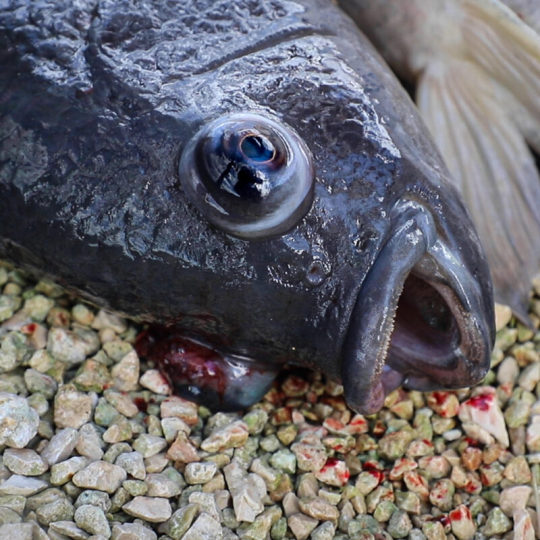
In commercial ocean fishing, the welfare concerns are mostly relegated to the final minutes or hours of a fish’s life — they’re typically left to suffocate to death on deck, which can take under an hour or up to several hours.
Other welfare issues include rough handling and the inability to express natural behaviors, like migration and nesting.
One of the bigger findings of the past two decades has been that fish have nociceptors, sensory neurons that detect and respond to damaging or threatening stimuli — a strong indicator they experience pain.
But just like with other species, researchers have repeatedly demonstrated that fish behave differently in adverse conditions (for example, they limit eating and activity) and stop these behaviors when pain relief is given.
They don't WANT to believe fish feel pain because it will lower their profits -- read the above again & honestly tell me that those fish don't sound like they were in pain & then relieved from pain -- so should they be left alone on ship decks to suffocate to death for HOURS???????????
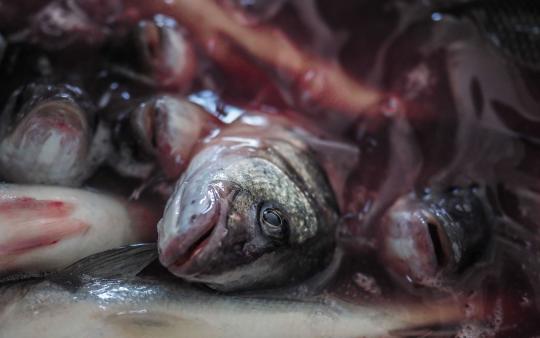
Wild-captured fish experience agonizing final moments no animal should have to endure, as pressure weighs on their bodies when they’re quickly pulled up out of the ocean’s depths in nets, and they begin to suffocate.
Death, too, is cruel on fish farms, where many fish are killed slowly by suffocation or in ice water.
Existing in these cramped environments is a far cry from the lives fish would experience in their natural habitats. For one example, salmon may swim spans of hundreds of miles to reach the ocean from the streams in which they hatched, and much farther as they reach feeding grounds, according to the U.S. Geological Survey. Sometimes, salmon will spend years at sea before returning to their original stream to spawn.
Extraction of groundwater for aquaculture has been found in one study to accelerate sea level rise by causing land to sink.
Pigs on factory farms are often cannibalized, forced to eat meat from fellow pigs.
WHERE IS OUR HUMANITY???????????
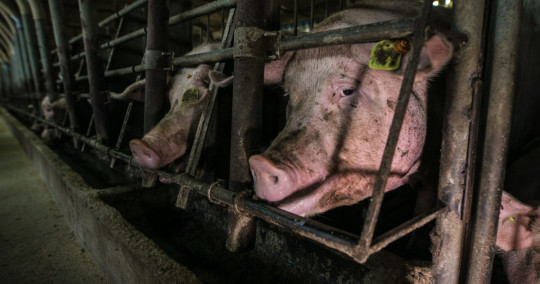
Where is humanity?
They are sentient beings: capable of feeling pain, and experiencing a range of emotions. Scientific evidence has revealed that fish are far more intelligent than people assume. They have long-term memories, complex social structures, problem solving abilities, and some have been seen using tools.
Fish are even crushed to death & literally cut in half while alive!
Where is humanity?
Porkopolis It is near impossible in the industry to encounter a conceptual or ethical limit proposed for sows biological reproductive capacity.

AnimalsAustralia Farrowing crates are cold, hard metal cages with steel or concrete floors. In factory farms around the world, it’s standard practice to transfer mother pigs to a farrowing crate 7-14 days before she gives birth to her new piglets. After birthing (in a process known as ‘farrowing’), she remains confined in these metal ‘maternity’ crates for 3-4 weeks until her piglets are weaned.
Farrowing crates are so small a mother pig can barely move – she can only sit, stand or lay down slowly, and with difficulty. Pigs are naturally very clean animals, and when given the choice, never toilet where they eat, sleep or play. Instead, they will often travel far away to relieve themselves. But trapped in a farrowing crate, she can only take one step forward or back and is forced to urinate and defecate right where she stands. For mother pigs, this unhygienic behaviour causes her extreme stress, discomfort and heightens her risk of disease.
Despite having the intelligence of a 3-year old child, who can solve puzzles and even play video games, have amazing memories, can sense the passing of time, foster lifelong friendships with other pigs and expresses empathy for humans and pigs alike, these loving animals continue to be industrialised and treated like 'products', rather than individuals who feel - and express - an enormous range of emotions. She is someone, not something.

Eggs are Not Eggscellent Cages are extremely cruel, and sadly they are just one of many cruelties chickens are forced to endure in the egg industry. In all commercial egg systems – cage, barn-raised, free-range or organic – male chicks are considered ‘worthless’ and are killed on their first day of life.
Female chicks are raised to replace hens who are sent to slaughter at just 18-30 months old — a fraction of their natural lifespan. As newborns, the tips of their beaks can be cut off without pain reliefto reduce aggressive pecking fueled by frustration when they cannot move freely, forage, or establish a natural social structure.
Because the males bred into the industry won’t grow up to produce eggs they are ‘disposed of’ by gassing or maceration -- literally being shredded to death while alive.
And later that year, at Sparboe Farms in Iowa, undercover investigators documented hens with gaping, untreated wounds laying eggs in cramped conditions among decaying corpses.

Leo Tolstoy - 1891 Essay A village pig is dragged outside for slaughter. The animals “human-looking pink body” screamed in a “dreadful voice, resembling the shriek of a man”.
After the screams subsided and the animal was killed, even the gruff carriage driver accompanying Tolstoy lets out a heavy sigh.
“Do people really not have to answer for such things?”
Almost 200 years later, do they answer for such things?
My question to anyone reading this (unless you are already a strict vegan) is:
What can you do to reduce the overall suffering & harm done to sentient beings (all animals including fish & cetaceans) that is realistic & repeatable over the long term?
Me, personally I do not see the point in being some total zealot that never eats anyhing with bone char again if it isn't sustainable over the long term.
Vegans call it doing what is "practical & possible".
I believe it is also very important that it be sustainable over the long term or else what was the point?
Now, I will end this by asking you the same question I asked myself:
What can you do to reduce the suffering & harm to sentient beings (all animals including fish & cetaceans) that fits the following two criteria:
Realistic
Repeatable over the long term
I also want to say this if you are a starseed reading this -- we need to work with everyone.
This isn't some kind of ideological purity test or a flex as I see a lot of that within the movement for animal rights & activism. This is about sentient, self-aware beings that are emotional, social & cognitively functional getting the living shit tortured out of them.
This is about the fact that 90% of the world's population as of today eats meat.
This is about 10 billion farm animals being slaughtered in the US every year for food.
This is about 99% of farm animals in the US being killed in factory farms.
This is about 90% of the 10 billion farm animals being slaughtered in the US being chickens.
This is about fedral subsidies that make a cheeseburger $4 when it should really be at least $15.
This is about big meat & big ag spending tens of millions every year to bankroll politicians for favorable policies.
This is about landmark legislation from the EPA & Congress not applying to the agricultural industry that causes the majority of land, air & water pollution & waste.
This is about the fact that there is no Big Broccoli to counter the meat & agricultural cartels.
This is about Trump winning.
It's not about fighting over bone char, cholecalciferol & cross contamination.
It's not about a competition on who can utilize the least animal byproducts (like the paint on the walls in your home & the tires in your car).
It's not a who's the best vegan dick measuring contest.
We need to work with everyone given what we are about against.
The 10 billion number has not dropped. And actually, people are consuming more meat.
Although there have been legislative wins and imitation meat like Impossible & Beyond Meat are promising.
They have the lobbying machine, political apparatus, laws, subsidies & constant commercials & ads on their side. When's the last time you saw a commercial for vegetables?
Now, when's the last time you saw a commercial for Sonics, Dominos, Pizza Hut, Burger King, Pringles, Lays, Reeses Cup, Snickers, Twix, Applebees, Chilis, McDonalds.
We need to work with omnis, flexitarians, pescatarians, people that don't eat pork, people that don't eat chicken, people that don't eat beef, people that don't consume dairy.
That's not watering down or diluting a message.
It's decentering zealotry so we can actually get somewhere in our fight for animals to be recognized as sentient beings with their own inalienable rights.
That is maybe 100 to 250+ years off.
We won't get anywhere if we stay on reddit debating about whether brown sugar is okay if it is processed with bone char.
Keep that in mind. The animals are counting on us. ✨✨✨

#vegan#veganism#antispeciesism#speciesism#big meat#big ag#trump#antispeciesist#vegetarian#animal liberation#go vegan#plant based#flexitarian#omnivore#factory farming#fast food#mcdonalds#kfc#burger king#pizza hut#corporatism#anti capitalism#climate change#starseed#starseeds
22 notes
·
View notes
Text
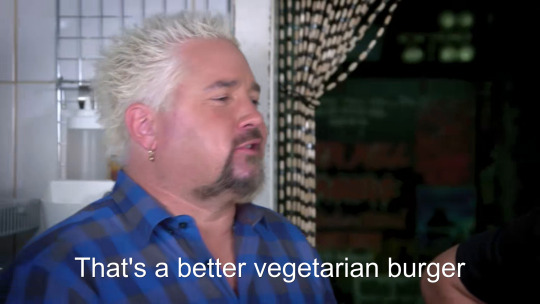
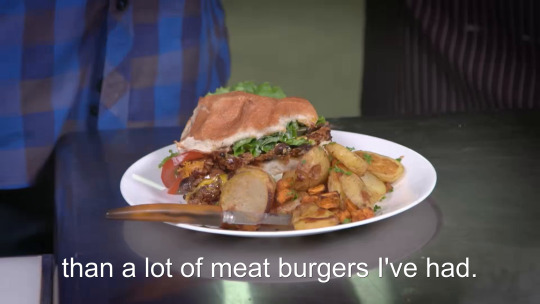

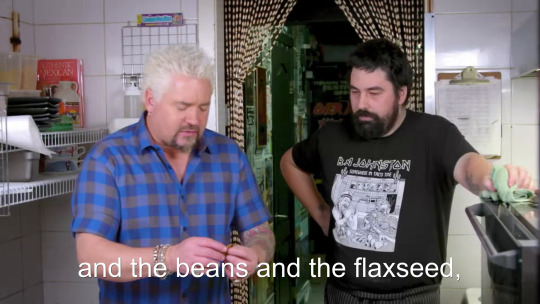
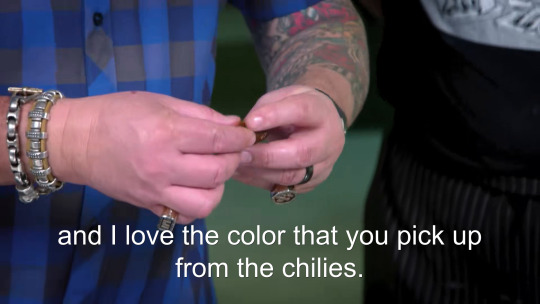
[That's a better vegetarian burger than a lot of meat burgers I've had. They convey neither conviction nor authority and the beans and the flaxseed, and I love the color that you pick up from the chilies.]
#s32e07 crazy chicken twisted burgers#guy fieri#guyfieri#diners drive-ins and dives#vegetarian burger#meat burgers#lot#conviction#authority#beans#flaxseed#color#chilies
6 notes
·
View notes
Text
So the restaurant the boys work at in The Heart Killers is
Heart Burger

29 notes
·
View notes
Text
Bro what the fuck are those prices I ain't gonna get the balls to order a sex joke for SIXTEEN DOLLARS

23 notes
·
View notes
Text


Veggie Burger stack ring set, Nadine Ghosn
#nadine ghosn#jewelry#so cute eat the rich tho#fashion#style#novelty#jewels#rings#food#burger#burgers#veganism#vegan#vegetarian#veggies#vegtables#ring
149 notes
·
View notes
Text
mista would be a climate change denier and antivaxxer
#in an alpha male way#he'd eat burgers to shit on vegetarians#mista#jjba#jojos bizarre adventure#jojo#vento aureo#golden wind
35 notes
·
View notes